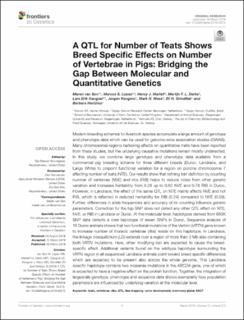| dc.description.abstract | Modern breeding schemes for livestock species accumulate a large amount of genotype
and phenotype data which can be used for genome-wide association studies (GWAS).
Many chromosomal regions harboring effects on quantitative traits have been reported
from these studies, but the underlying causative mutations remain mostly undetected.
In this study, we combine large genotype and phenotype data available from a
commercial pig breeding scheme for three different breeds (Duroc, Landrace, and
Large White) to pinpoint functional variation for a region on porcine chromosome 7
affecting number of teats (NTE). Our results show that refining trait definition by counting
number of vertebrae (NVE) and ribs (RIB) helps to reduce noise from other genetic
variation and increases heritability from 0.28 up to 0.62 NVE and 0.78 RIB in Duroc.
However, in Landrace, the effect of the same QTL on NTE mainly affects NVE and not
RIB, which is reflected in reduced heritability for RIB (0.24) compared to NVE (0.59).
Further, differences in allele frequencies and accuracy of rib counting influence genetic
parameters. Correction for the top SNP does not detect any other QTL effect on NTE,
NVE, or RIB in Landrace or Duroc. At the molecular level, haplotypes derived from 660K
SNP data detects a core haplotype of seven SNPs in Duroc. Sequence analysis of
16 Duroc animals shows that two functional mutations of the Vertnin (VRTN) gene known
to increase number of thoracic vertebrae (ribs) reside on this haplotype. In Landrace,
the linkage disequilibrium (LD) extends over a region of more than 3 Mb also containing
both VRTN mutations. Here, other modifying loci are expected to cause the breedspecific
effect. Additional variants found on the wildtype haplotype surrounding the
VRTN region in all sequenced Landrace animals point toward breed specific differences
which are expected to be present also across the whole genome. This Landrace
specific haplotype contains two missense mutations in the ABCD4 gene, one of which
is expected to have a negative effect on the protein function. Together, the integration of
largescale genotype, phenotype and sequence data shows exemplarily how population
parameters are influenced by underlying variation at the molecular level. | en_US |

